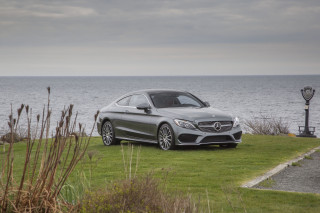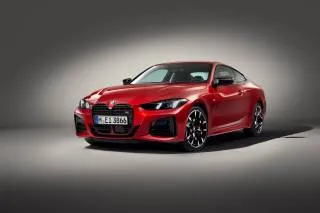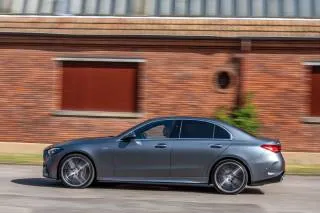Likes
- Impressive performance
- Rides well
- Balanced chassis
- More stylish than the M3...
Dislikes
- …but less practical
- Cramped rear seat
- Heavy convertible
- Lack of steering feel
Buying tip
features & specs
The 2018 BMW M4 lives up to its heritage as an entertaining performance car, both on the track and your favorite twisty road.
Take the long way in the 2018 BMW 4-Series.
The coupe, convertible, or four-door “coupe” from the automaker is BMW’s best expression of a boulevardier for now.
It’s loosely based on the four-door 3-Series, but the 430i or 440i is addition by subtraction in the BMW range. Most versions of the 4-Series pare down the number of doors from four to two, and pare down the available powertrains from the 3-Series to two of BMW’s best.
We give the range a 6.8 overall, which is buoyed by its exterior style, better standard features, and good performance. (Read more about how we rate cars.)
This year, the 4-Series received a very light revision—only the front and rear bumpers are discernibly different.
The 430i is powered by a turbo-4 that’s confident and responsive. The 2.0-liter engine is rated at 248 horsepower and 258 pound-feet and is paired with an 8-speed automatic in most versions, or a 6-speed manual in rear-drive coupes.
A 3.0-liter turbocharged inline-6 powers 440i versions and compels the coupe, convertible, or sedan up to 60 mph in less than five seconds.
All-wheel drive is available in every body style, but the manual isn’t; only rear-wheel-drive coupes can row their own.
This year, BMW revised their suspensions—available in standard, M sport, or adaptive configurations—to be slightly stiffer and sportier. The differences between model years might be barely perceptible, but that’s not a bad thing. Every 4-Series steer well—with a hint of wander at slow speeds—and its lower center of gravity than the 3-Series contributes to better composure on the road.
Four adults in the 4-Series is a stretch, we think two aboard are better served. Those with different ideas should consider the 4-Series Gran Coupe that makes entry and exit easier to the rear row.
The base 4-Series is better equipped this year with a newly standard rearview camera and 6.5-inch infotainment display. Base models are equipped with synthetic leather that’s not easily confused with the real thing; we’d advise adding real leather hides instead of splurging on navigation or pricey tech add-ons.
2018 BMW 4-Series Styling
The 2018 BMW 4-Series coupe and convertible are handsome, but its best look comes with four doors.
The 2018 BMW 4-Series is revised this year with new headlights and a new tail, but neither spoil the car’s arresting dimensions.
We give the 4-Series points above average for its interior and exterior but stop from going further. It earns a 7 out of 10. (Read more about how we rate cars.)
Although the 4-Series is new this year, we’re hard-pressed to spot the differences—and we’re paid to notice them too.
That’s OK because it doesn’t spoil what the 4-Series had going for it in the first place: its proportions. The 4-Series sports a relatively long nose and swept-back windshield that cuts a sleeker hole in the wind. Along the sides, the 4-Series is more restrained than the Mercedes-Benz C-Class it most closely competes with—we’re split on whether that’s a good thing.
Inside, the 4-Series is starched-shirt, tucked-in tight. It dispatches with curves and organic shapes for mostly straight lines and a horizontal orientation, but it’s not boring.
The 4-Series Gran Coupe is the looker of the bunch with a more elegant roofline and two rear doors that add function without subtracting style. It’s priced comparably to the coupe this year, which should give some buyers pause before opting for the sleek two-door.
2018 BMW 4-Series Performance
The 2018 BMW 4-Series is a solid performer thanks to a good base engine and better 8-speed automatic transmission.
Unlike the 3-Series that it’s based on, the 2018 BMW 4-Series spares us the periphery and delivers mostly good stuff.
Available as a 430i or 440i, with or without all-wheel drive, the 4-Series is a greatest hits collection of current BMW powertrains.
We give it a 7 out of 10 for its good 8-speed automatic and its good grip on the road. (Read more about how we rate cars.)
We wouldn’t overlook the base engine, either. Badged as a 430i, the base 2.0-liter turbo-4 is among the best and makes 248 horsepower and 258 pound-feet of torque. It’s frisky enough to run those models up to 60 mph in less than six seconds, and sedate enough to return more than 30 mpg on the highway. We like its broad power delivery across the rev range and its spunky attitude, especially when paired to BMW’s near-telepathic 8-speed automatic.
BMW purists might be tempted by the 440i’s turbocharged 3.0-liter inline-6 and they won’t be disappointed. Its 320 hp and 330 lb-ft pulls with urgency and stands up favorably to the Audi S5 and Mercedes-Benz C43 coupes. The 2018 BMW 440i holds aces over both those models too: it can be equipped with rear-wheel drive and a manual transmission in coupe models—the other two can’t.
That manual transmission will be a rare sight, though. It’s limited to rear-drive coupes—no convertible or Gran Coupe can row its own. That’s not necessarily a bad thing either.
BMW’s 8-speed automatic has earned our praise in plenty of applications, and the 4-Series is no different. It’s a conventional automatic, but it fires off rapid shifts like a dual-clutch. Tip the shifter over to “Sport” mode and the automatic holds gears longer, which keeps the turbos poised to pounce.
Like other BMWs, the 4-Series is available with an unobtrusive all-wheel-drive system, dubbed “xDrive.” It moves power up and down the driveline based on available grip, wheel spin, throttle position, or lateral acceleration. The system defaults to a 40/60, front-to-rear power split, but can send all of its power to the front or rear wheels as needed.
This year, the 4-Series slightly improved its responsiveness with improvements to its suspension. The overall setup is stiffer than last year’s model at every stop: standard suspension, M Sport suspension, or adaptive dampers. The car we tested featured adaptive dampers, which toggle between normal and sport settings with plenty of differentiation between the two. Like the 3-Series, the 4-Series is flat and composed, with less body lean than some of its competitors. The 4-Series steers confidently, but its wheel feels artificially heavy in Sport or Sport+ mode and requires some correction at low speeds.
The BMW’s steering isn’t as quick as Mercedes’ AMG cars nor the Alfa Romeo Giulia, but it’s not as nervous either.
2018 BMW 4-Series Comfort & Quality
Two-door coupes and convertibles like the 2018 BMW 4-Series aren’t the most practical, but they are the most fun.
The 2018 BMW 4-Series is a stylish coupe, convertible, or sedan that willingly sacrifices some substance for style.
The best seats are the front seats and we’d think twice before asking adults to sit in the rear seats in the coupe or convertible.
Starting from an average score, the 4-Series gets points for above average front seats but loses one for false advertising: seating five isn’t possible. We land at a 5. (Read more about how we rate cars.)
Our rating is based on the 4-Series coupe, which we think will be the most popular pick for customers. The convertible loses a roof but doesn’t add much more comfort. The Gran Coupe is best suited for more than two, and its price makes it a compelling choice for shoppers—it’s $200 less than the coupe.
Regardless of body style, the 4-Series offers comfortable, power-adjustable front seats shod in synthetic leather. The dash and its materials have aged relatively well and still have a tactile feeling when other competitors have gone needlessly complex or needlessly flimsy—or both. (The center console has too much hard plastic for our tastes, however.) Warmer tones bring out the dashboard’s style and elegance more than darker shades.
For front-seat riders, the 4-Series is comfortable and quiet. Standard power-adjustable front seats can be upgraded to luxury buckets with more adjustability, but most body types won’t struggle to find a long-haul groove. The 4-Series’ low roofline cuts into outward vision for tall drivers or long torsos; our 6-foot-3 editor’s sightlines were compromised by a bulky rearview mirror assembly.
In back, the 4-Series has two tales to tell. Adults won’t fit comfortably in coupes or convertibles for long stretches without negotiating with front-seat passengers. Getting into or out of those seats requires checking some integrity—and modesty—curbside.
The rear seats in Gran Coupe versions have the same 33.7 inches of leg room as the coupe or convertible, but they’re more easily accessible and more useful because of those doors.
Gran Coupes offer the most cargo space with 17 cubic feet, followed by coupes (15.7 cubes) and convertibles (13.1).
The 4-Series is mostly quiet and composed on the road, with little engine noise filtering in through the cabin. Aside from some ergonomic quibbles such as the hidden switch for the heated steering wheel and the far-forward infotainment controller, the 4-Series is comfortable. If “roofless” is on the shopping list, the 4-Series’ lid tumbles back in 20 seconds at speeds up to 11 mph.
2018 BMW 4-Series Safety
The 2018 BMW 4-Series hasn’t yet been crash-tested.
The BMW 4-Series has skipped comprehensive crash-testing from the NHTSA and the IIHS since it was new. That lack of official safety data means that we skip rating it too. (Read more about how we rate cars.)
The 4-Series is related to the 3-Series, which is a Top Safety Pick by the IIHS, but structurally different enough that the two don’t directly translate.
The 4-Series is equipped with a standard complement of safety features if push comes to a wall—or another vehicle. BMW fits as standard front passenger head and knee airbags, and rear side curtain airbags in every 4-Series. BMW’s emergency notification system alerts first responders if the 4-Series is in a serious crash too.
Active safety features such as blind-spot monitors, adaptive cruise control, and active lane control are available, but cost $2,200 when all bundled into a car. That’s too much for us, and other non-luxury automakers such as Toyota are adding into their cars as standard equipment.
A rearview camera is standard on all 4-Series this year.
2018 BMW 4-Series Features
Reasonably equipped in base configuration, the 2018 BMW 4-Series can be as rich as your pockets will allow.
The 2018 BMW 4-Series is better equipped from the factory than previous years.
Base coupes start at more than $44,000 and are equipped with synthetic leather upholstery, 18-inch wheels, a moonroof, power-adjustable front seats, automatic climate controls, Bluetooth connectivity, a 6.5-inch infotainment screen, and a rearview camera.
That’s good base equipment, good options are available, and BMW offers its typical menu of (pricey) comprehensive add-ons—three points there. Its base infotainment screen is big enough to earn another point, but its click-wheel controller and pricey Apple CarPlay compatibility is enough to take it back. We land at an 8 for features. (Read more about how we rate cars.)
Base convertibles and Gran Coupes are equipped nearly identically to the coupe—the convertible skips the moonroof for the, you know, moon.
Trading up to the bigger engine in 440i versions add as standard premium audio by Harman Kardon, satellite radio, and a nappa leather steering wheel.
Option packages for the 4-Series split into two camps: sporty or luxury. A luxury package adds better 18-inch wheels, more exterior chrome, wood interior accents, and premium audio to 430i models. A premium package goes further with navigation, BMW telematics, and a digital driver information display. An executive package exhausts all synonyms for “luxury” and adds a surround-view camera system, automatic headlights, parking assistance, and a head-up display.
Don’t feel like a nut this time? Sport packages change directions from luxury trims and add a thicker steering wheel, blacked-out kidney grilles, stiffer suspension, and sporty exterior add-ons. Adaptive dampers are a low-cost add-on for cars equipped with sport packages.
Navigation and telematics are available on M Sport cars too.
A small handful of a la carte options are available and are perhaps better values than the spendy packages. Heated seats and a heated steering wheel should be on the short list for buyers living in snowy states. Blind spot monitors, adaptive cruise control, and active lane control are each available, but add $2,200 to the bottom line when the three are selected together. Apple CarPlay is available for $300 extra, but we don’t recommend it; adding CarPlay requires navigation, which costs $2,300 more. Not only does that mean CarPlay is effectively a $2,600 add-on, it also doesn’t run very well via BMW’s click-wheel controller.
Our advice? Stick with BMW’s native iDrive system and add navigation only if you need it.
2018 BMW 4-Series Fuel Economy
The 2018 BMW 4-Series’ fuel economy isn’t bad, but it’s not better than luxury competitors.
Turbocharged engines that help make the 2018 BMW 4-Series fun to drive also help keep it relatively fuel-efficient. Regardless of powertrain, driven wheels, or body style, the BMW 4-Series returns combined mileage in the mid-20s on premium unleaded.
Base coupes with a turbo-4 and rear-wheel drive are the most popular and they return a EPA-estimated 24 mpg city, 34 highway, 27 combined. That’s good enough for a 7 out of 10 on our efficiency scale and other models don’t stray far from there. (Read more about how we rate cars.)
Adding two doors or removing a roof doesn’t impact fuel economy; 430i convertibles and 430i Gran Coupes are rated identically to the two-door version. Adding optional all-wheel drive, which BMW calls xDrive, shaves 1 mpg from the city and highway ratings in the coupe and Gran Coupe, 2 mpg from each in the convertible.
Opt for the larger engine in the 440i and ratings tumble. With hard tops, the 440i is rated at 21/32/25 mpg, or 21/29/24 mpg in the convertible. Adding all-wheel drive shaves roughly 1 mpg from the city and highway ratings.
A 6-speed manual is offered in 430i and 440i coupes with rear-wheel drive but doesn’t help fuel economy. The 430i is rated at 21/33/25 mpg and the 440i is rated at 19/29/33 mpg.
Competitors from Audi, Mercedes-Benz, Infiniti, and Cadillac all return nearly identical numbers.








































































































